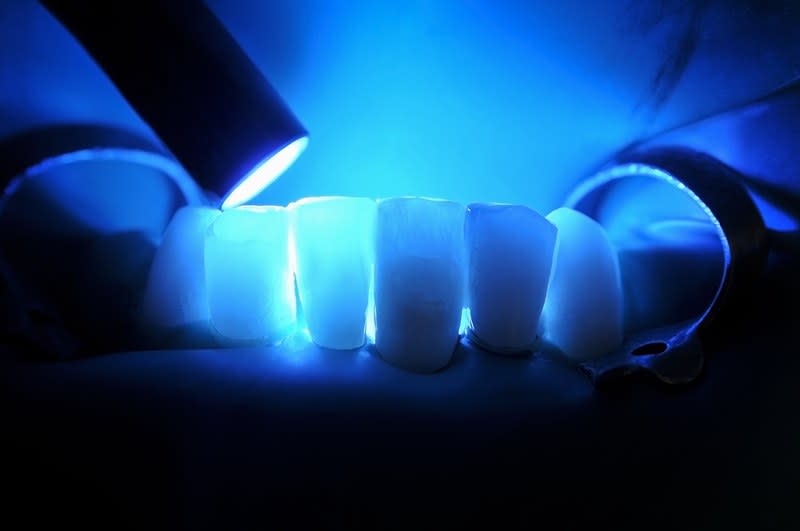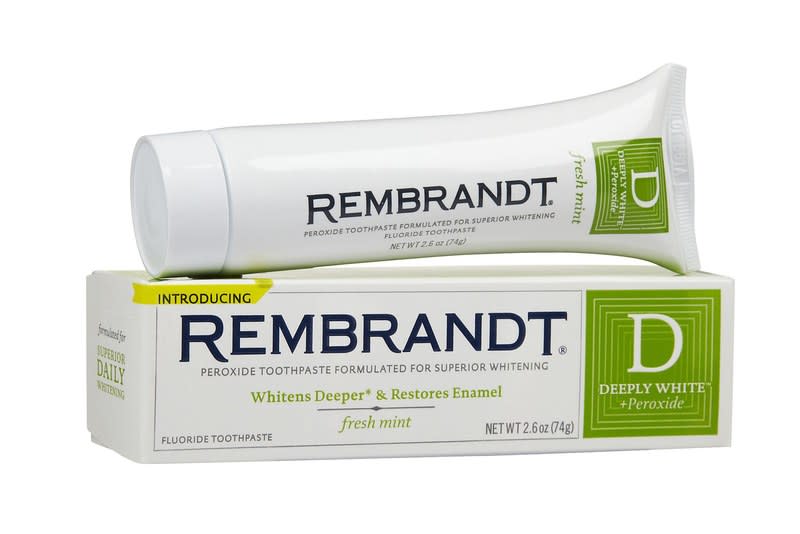What's the Best Way To Get White Teeth, Fast?
By Stephen J. Praetorius.
Who doesn’t want white teeth? Honestly, though. The fact is that perfect, yellow-free tusks have been one of the most universally aspired to ideals for ages, so much so that should anyone ever tell you that they’re 100% satisfied with their smile, you can bet your ass that they’re either lying to you, themselves, or, most likely, both. The good news is that there are distinct factors that lead to discoloration, and ruling them out early can keep your teeth their brilliant selves for as long as possible. The bad, however, is that more often than not people get to these too late, long after the damage has been done.
RELATED: 5 GQ-Approved Products to Improve Your Smile (and Freshen Your Breath)
Which is why millions of people turn to whitening products each year, in hopes that they can renew their once pristine white teeth to their former glory. And when they do, they’ve got a number to choose from (not to mention a slew of new gadgets). From toothpastes that tout themselves as effective to whitening strips, gels, and even dental procedures, deciding which means to a pearly white end can be tough. So we’ve done the work for you, providing the pros and cons for all the methods out there. Now all you need to do is choose wisely.
Whitening Toothpastes
How They Work: The basic concept surrounding your standard, over-the-counter whitening toothpaste is simple—to remove surface stains and discoloration. How does it do this? By employing polishers and abrasives, which buff away dark spots, plus gentle chemical bleaching agents.
The Good: First off, there’s the price; these are by far the most universally used form of whitening, and for good reason. You can easily pick up a tube for a five-spot, though, of course, you can upgrade to more expensive options. Aside from that though, they’re also hella easy to use, and effective, to an extent. Sure, you won’t all of a sudden be blessed with perfect chompers, but it’ll help.
The Bad: We’ve talked about this before, but because of how they work, whitening toothpastes can actually do more harm than good if overused, wearing away delicate enamel that you need to protect your teeth from stressors like sugar, acid, and plaque on the daily.
Whitening Strips
How They Work: As opposed to toothpastes, whitening strips work largely as a result of whitening chemicals, specifically peroxides and bleaches. These chemicals are, as you would expect, on two plastic strips, one for your top set of teeth and another for your bottom, and while they’re affixed, the whitening chemicals make their way into your teeth and remove inset stains.
The Good: They’re easy as hell. Seriously, all you need to do is slap them on, wait the recommended amount of time, then take them off. Plus, they’re effective; it’ll only take a few days of use for your teeth to look noticeably whiter.
The Bad: The trouble with chemicals is, well, they’re chemicals. Meaning that they can be kind of troublesome if you don’t pay close attention. For example, some strips are made with chlorine dioxide, a chemical that can actually eat away at enamel if you leave it on too long. There’s also the issue of reach; often, strips will cover only the bottom half of the teeth, effectively leaving along the gumline just as yellow as it started off. Finally, there’s the problem of increased sensitivity post-strip. Not at all ideal.
Whitening Gels
How They Work: Take everything we said about tooth whitening strips, chemicals and all, and repeat it sans the strips. Instead, gels are either brushed onto the teeth, or squeezed into a jaw-shaped tray, which you’ll then affix onto your teeth for the recommended time. After the designated time has passed, often overnight, you’ll then either brush away the gel or remove the tray.
The Good: The biggest thing here is that they’re thorough, since you apply the gels either directly to the teeth or in excess to the tray. That means that all the little nooks and crannies of your teeth get whitened, from the tips to the tops. Also, the trays stay is place a bit better than the strips, since there’s no adhesive that can come unstuck.
The Bad: Exactly the same as strips here. Chemicals, man. Can whiten with ‘em, can’t whiten without ‘em.
Whitening At The Dentist
How It Works: The general gist goes a little something like the following. After a cheek retractor is put in your mouth, to keep your skin away from your teeth, a whitening gel containing high percentages of hydrogen peroxide is applied to your teeth. It’s left on for anywhere between 15 minutes to half an hour, washed away thoroughly, then reapplied one or more times until the desired result is acquired. Sometimes, they’ll shine a bright light on your teeth to speed along the process.
The Good: Two words: professional supervision. It’s always a good idea to have someone who knows that they’re doing in charge, and this way, there’s always someone there to take a look while it’s happening. Also, results are instantaneous, so you don’t have to wait days or weeks to see whitening start to take shape.
The Bad: Price. This shit doesn’t come cheap, to say the least, with a single session costing up to $650. Results aren’t always consistent either, depending on age, type of stains, and a number of other factors. Oh, and also you’ve got to watch out for what you eat directly after, which is doable, but a pain.
Maybe a few stains aren’t so bad, after all.
This story originally appeared on GQ.
More from GQ:
Brad Pitt's 50 Most Stylish GQ Moments
Cristiano Ronaldo Has Mankind's Greatest Body
President Obama and Bill Simmons: The GQ Interview





